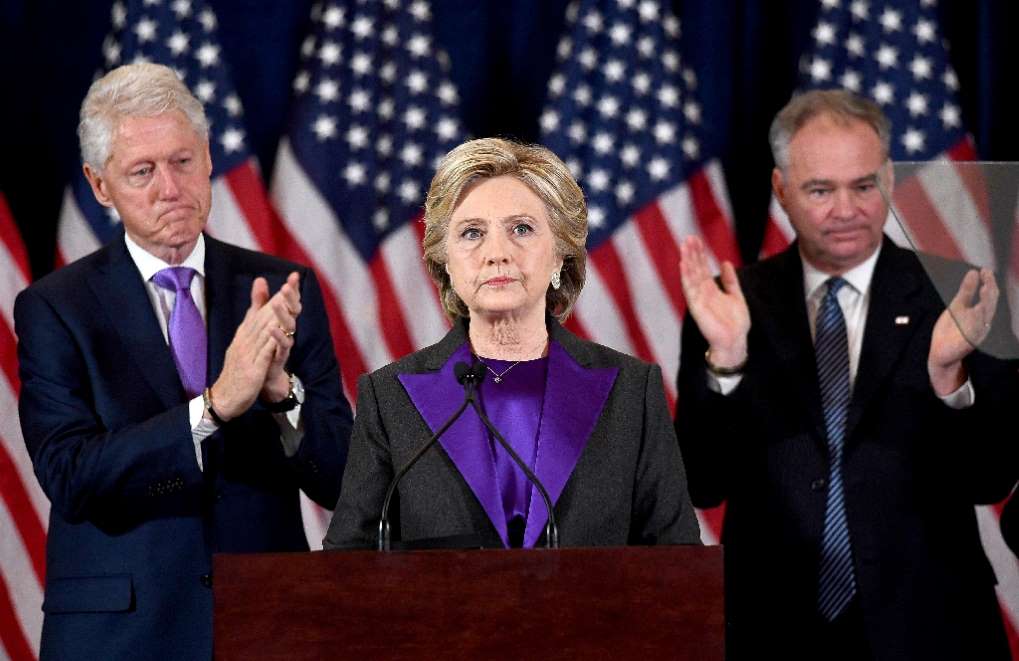April 30, 2017
WASHINGTON — A group of top Democratic Party strategists have used new data about last year's presidential election to reach a startling conclusion about why Hillary Clinton lost. Now they just need to persuade the rest of the party they're right.

April 30, 2017
WASHINGTON — A group of top Democratic Party strategists have used new data about last year's presidential election to reach a startling conclusion about why Hillary Clinton lost. Now they just need to persuade the rest of the party they're right.

"We owe him an open mind and the chance to lead," said Democratic presidential candidate Hillary Clinton (C) at a concession speech, after being defeated by Republican presidential-elect Donald Trump
Many Democrats have a shorthand explanation for Clinton's defeat: Her base didn't turn out, Donald Trump's did and the difference was too much to overcome.
But new information shows that Clinton had a much bigger problem with voters who had supported President Barack Obama in 2012 but backed Trump four years later.
Those Obama-Trump voters effectively accounted for more than two-thirds of the reason Clinton lost, according to Matt Canter, a senior vice president of the Democratic political firm Global Strategy Group. In his group's analysis, about 70 percent of Clinton's failure to reach Obama's vote total in 2012 was because she lost these voters.
Canter and other members of Global Strategy Group have delivered a detailed report of their findings to senators, congressmen, fellow operatives and think tank wonks — all part of an effort to educate party leaders about what the data say really happened in last year's election.
"We have to make sure we learn the right lesson from 2016, that we don't just draw the lesson that makes us feel good at night, make us sleep well at night," Canter said.
His firm's conclusion is shared broadly by other Democrats who have examined the data, including senior members of Clinton's campaign and officials at the Democratic data and analytics firm Catalist. (The New York Times, in its own analysis, reached a similar conclusion.)
Each group made its assessment by analyzing voter files –– reports that show who voted in every state, and matching them to existing data about the voters, including demographic information and voting history. The groups determined how people voted — in what amounts to the most comprehensive way to analyze the electorate short of a full census.
The findings are significant for a Democratic Party, at a historic low point, that's trying to figure out how it can win back power. Much of the debate over how to proceed has centered on whether the party should try to win back working-class white voters — who make up most of the Obama-Trump voters — or focus instead on mobilizing its base.
Turning out the base is not good enough, the data suggest.
"This idea that Democrats can somehow ignore this constituency and just turn out more of our voters, the math doesn't work," Canter said. "We have to do both."
Democrats are quick to acknowledge that even if voters switching allegiance had been Clinton's biggest problem, in such a close election she still could have defeated Trump with better turnout. For example, she could have won if African-American turnout in Michigan and Florida matched 2012's.
They also emphasize the need for the party to continue finding ways to stoke its base. Democrats can do both, said Guy Cecil, chairman of Priorities USA, a super PAC that backed Clinton last year and now is trying to help Democrats return to power.
"I really do believe that we should reject this idea that if we just focus on turnout and the Democratic base that that will be enough," he said. "If that really is our approach, we're going to lose six or seven Senate seats in this election. But, I also believe that just talking about persuasion means we are not capitalizing on an enormous opportunity."
Priorities USA released a poll last week, conducted in part by Cantor's firm, that found the Democratic base — including voters who usually sit out midterm elections —unusually motivated to participate in the next election. The group have said in recent months that Democrats can both reach out to white working-class voters and their base with a strong message rooted in economic populism.
Still, the data say turnout was less of a problem for Clinton than defections were. Even the oft-predicted surge of new voters backing Trump was more myth than reality. Global Strategy Group's review of Ohio, with Catalist, found that Clinton won a majority of new voters in the state. (Global Strategy Group examined North Carolina, Pennsylvania, Ohio and Nevada as part of its analysis).
Belief that turnout was the main reason Clinton lost, however, remains a prominent theory among Democrats.
"There's an active conversation within the party about whether persuasion was the problem or turnout," said Lanae Erickson Hatalsky, vice president for social policy and politics at Third Way, a center-left Democratic think tank.
That debate is complicated because some Democrats think winning over voters is already a lost cause, Hatalsky said.
"There's still a real concern that persuasion is harder and costs more than mobilization, so let's just triple down on getting out the people who already agree with us," she said. "And I think there's a lot of worry that we don't actually know how to persuade anymore, and so maybe we should just go talk to the people we agree with."
A conversation about where Democrats go next as a party inevitably turns into a discussion about whether it should embrace a form of economic populism similar to one pushed by Sen Bernie Sanders, or move instead to the political middle.
Canter argued that Trump's president's "special sauce" combines his economic populism with a political populism that vilifies both parties.
But he rejected the notion that his firm's report suggests the party should pursue either direction. Rather, he said he and his partners were simply trying to explain to party leaders exactly why Clinton lost.
Without understanding how the party lost, it's hard to figure out how it can win again.
"We don't need to be Republican lite," Canter said. "All we're saying is this is the electoral challenge. In order to win, this is the challenge we have to solve. And there are a lot of good arguments for how we can solve it."
Courtesy: Tribune Washington Bureau
















































































































